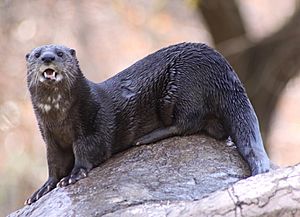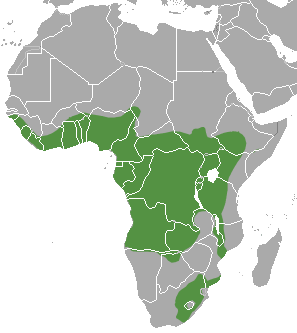Spotted-necked otter facts for kids
Quick facts for kids Spotted-necked otter |
|
|---|---|
 |
|
| Conservation status | |
| Scientific classification | |
| Genus: |
Hydrictis
|
| Species: |
maculicollis
|
 |
|
| Distribution of spotted-necked otter | |
| Synonyms | |
|
Lutra maculicollis |
|
The spotted-necked otter (Hydrictis maculicollis) is a type of otter that lives in Africa. It is also known as the speckle-throated otter because of the spots on its neck and throat. These playful animals are native to sub-Saharan Africa, which is the part of Africa south of the Sahara Desert. They are often found near fresh water, like rivers, lakes, and swamps.
Contents
What is a Spotted-Necked Otter?
The spotted-necked otter is a medium-sized otter. It has a long, slender body and a flat head. Its fur is usually brown or reddish-brown. The most special thing about it is the white or cream-colored spots on its neck and chest. These spots are unique to each otter, like a human's fingerprints! They have webbed feet, which help them swim very fast. Their strong tails also help them steer in the water.
Where Do They Live?
Spotted-necked otters live in many different parts of sub-Saharan Africa. You can find them in countries like South Africa, Kenya, Uganda, and Nigeria. They prefer areas with lots of water, especially places with clear, clean water. They need places where they can find plenty of fish to eat. They also like areas with thick plants along the riverbanks. These plants give them good places to hide and rest.
Their Habitat
Their homes are usually close to water. This includes large rivers, calm lakes, and even swamps. They like areas where the water moves slowly. They also need places on land to build their dens. These dens are often found in burrows, under tree roots, or in rocky cracks. They use these dens to sleep and raise their young.
What Do They Eat?
Spotted-necked otters are carnivores, which means they eat meat. Their main food source is fish. They are excellent hunters in the water. They use their sharp teeth and strong jaws to catch slippery fish.
Hunting Habits
These otters are very skilled at fishing. They often hunt alone or in small groups. They use their good eyesight and whiskers to find prey in the water. Their whiskers are very sensitive and can feel the tiny movements of fish. Once they spot a fish, they chase it quickly through the water. They can hold their breath for a long time, which helps them catch fish underwater. Besides fish, they might also eat frogs, crabs, or even small birds if they can catch them.
Life Cycle and Reproduction
Spotted-necked otters usually have one to three pups (baby otters) at a time. The mother otter takes care of her pups in a safe den.
Raising Young Otters
Baby otters are born blind and helpless. They depend entirely on their mother for food and protection. The mother teaches them how to swim and hunt. This learning process is very important for the pups to survive on their own. They stay with their mother for several months, learning all the skills they need to be independent. Otters are known for being playful, and the young ones learn a lot through play.
Conservation Status
The spotted-necked otter is currently listed as "Near Threatened" by the International Union for Conservation of Nature (IUCN). This means that while they are not in immediate danger, their numbers are decreasing.
Threats to Otters
One of the biggest threats to spotted-necked otters is habitat loss. As human populations grow, more land is used for farming or building. This means less space for otters and their homes. Water pollution is also a big problem. Chemicals and trash in rivers and lakes can harm the fish they eat and make the otters sick. Sometimes, otters are also hunted for their fur or because they are seen as pests by fishermen.
Protecting Otters
Many groups are working to protect spotted-necked otters. This includes creating protected areas where they can live safely. It also involves cleaning up rivers and lakes to reduce pollution. Educating people about the importance of otters helps too. By understanding these animals, we can all help make sure they have a future.
Images for kids
See also
 In Spanish: Nutria de cuello manchado para niños
In Spanish: Nutria de cuello manchado para niños



